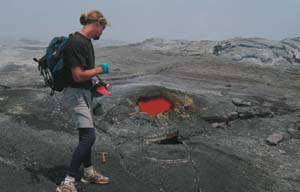 |
 |
| current issue |  |
past issues |  |
send a letter/news |  |
address update |  |
advertise |  |
about us |  |
alumni home |
Features
Volcano SongsLike elephants and whales, volcanoes produce low-frequency sound that carries a message
by Robert Emro

|
On Nov. 13, 1985, Nevado del Ruiz erupted in Colombia. As eruptions go, it was small. But it was also deadly. Approximately 23,000 people died and the entire town of Armero was destroyed, not by hot lava but by rivers of mud the consistency of wet concrete that came roaring down steep mountain valleys like freight trains, picking up trees, boulders and speed before converging on the town more than 40 miles away.
Nevado del Ruiz was the second most deadly volcanic event of the last century. Only Mt. PelŽe, on the Caribbean island of Martinique, was worse, claiming 29,000 lives when it destroyed the capital city, St. Pierre, in 1902.
Of the roughly 1,500 active volcanoes on earth, between 50 and 70 erupt in any given year. Worldwide, approximately 500 million people live in volcano danger zones. UNH volcanologist Jeff Johnson is working to help them avoid the fate of the residents of Armero and St. Pierre. "Hazard mitigation has been one of my main drives from the beginning," says Johnson, a research assistant professor in the UNH earth sciences department.
Johnson studies the infrasound produced by volcanoes to better understand how they erupt and, as a result, to better predict eruptions. Unlike earthquakes, which give few warning signs before they strike, active volcanoes broadcast acoustic signals—songs, if you will—that can tip off anyone who is listening.

|
These low-frequency sound waves are a largely untapped resource for volcano monitoring, says Johnson. "I give talks all the time promoting the value of this science," he says, noting that the monitors are relatively inexpensive to install. Officials are starting to take heed. In November, Johnson helped Mexican volcanologists install permanent infrasonic microphones at Volcan de Colima, considered to be the most active and, potentially, the most destructive of nine volcanoes located in central Mexico. Also last year, Johnson built microphones for a permanent network at Mt. Erebus on Ross Island in Antarctica. "For a long time now, we have been installing microphones as part of short-duration geophysical experiments. Now is the time to get permanent installations in place and focus on the interpretation of sound, so that local monitoring officials can use the data to figure out exactly what is going on at their volcano," he says.
Akin to the seismic waves that travel through the ground when the earth quakes, infrasound travels through the air when the atmosphere is disturbed. By definition, infrasound is low frequency (under 20 hertz), so low that humans can't hear it. Whales and elephants can send and hear infrasound, however, and use it to communicate across great distances. Nuclear blasts also produce infrasound, which is why the superpowers listen for it to monitor test bans. Other sources of infrasound include avalanches, meteorites, lightning and waterfalls. Johnson discovered this last source of infrasound serendipitously while recently researching an Ecuadorian volcano that happened to be located near 475-foot San Rafael Falls.
 HOT ROCKS: Research assistant professor Jeff Johnson, above, approaches a lava tube at Kilauea volcano on the island of Hawaii.
HOT ROCKS: Research assistant professor Jeff Johnson, above, approaches a lava tube at Kilauea volcano on the island of Hawaii.
|
Krakatoa produced the first recorded instance of volcanic infrasound when it erupted in Indonesia in 1883. The powerful explosion created a ripple in the atmosphere that circled the globe seven times: Scientists noticed the corresponding changes in air pressure on their barometers. But using infrasound to study volcanoes is relatively new. In fact, Johnson started out as a traditional seismologist. At Stanford, his first study in the field was collecting data on earthquakes in the Himalayas of Pakistan. While studying volcano-generated earthquakes at the University of Washington, Johnson's fluency in Russian—which he picked up as a foreign-exchange student to the former Soviet Union in 1989—helped land him a spot on three expeditions to the Karymsky volcano on the Kamchatka Peninsula. An advisor suggested he build a microphone to monitor infrasound as a complement to the seismic data.
"Back then, very few people were studying sound from volcanoes," says Johnson. "I figured this was a novel opportunity to use this method to learn how volcanoes erupt." When combined with seismic recordings, infrasound can help volcanologists monitor the frequency, intensity and nature of eruptions over time—information vital to predicting small events, as well as life-threatening eruptions or ash plumes that can bring down jet planes. "There's a lot of rich information in these acoustic signals," says Johnson.
Page: 1 2 Next >Easy to print version
blog comments powered by Disqus

